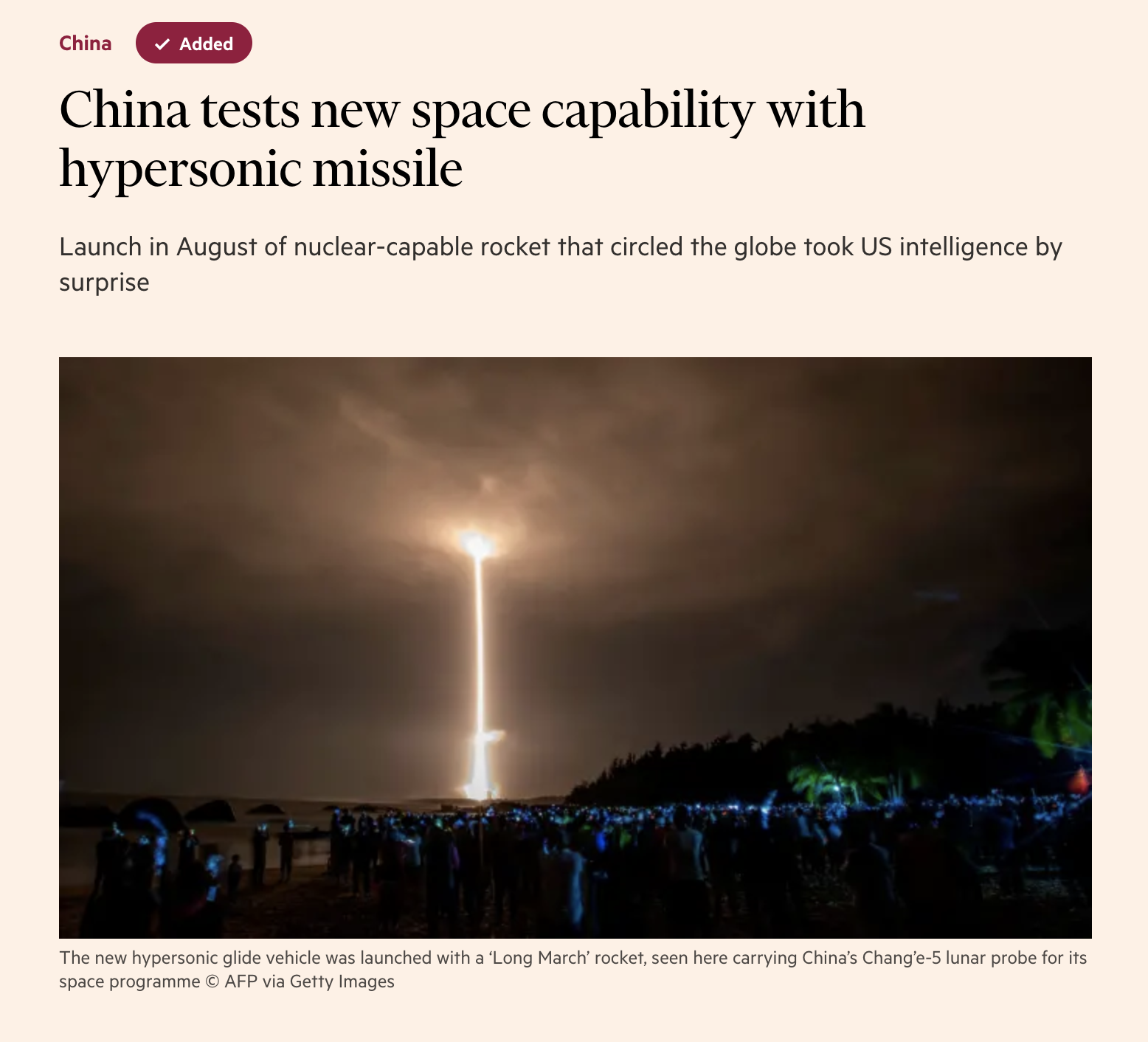
Editor's note: CGTN's First Voice provides instant commentary on breaking stories. The daily column clarifies emerging issues and better defines the news agenda, offering a Chinese perspective on the latest global events.
Over the weekend, a report was leaked to the Financial Times from anonymous U.S. sources who claimed that China had tested an orbital hypersonic missile capable of carrying a nuclear warhead, which apparently traveled around the world. It has incited a great uproar in the national security and diplomatic circles in the U.S. Many are stunned by the report and became fearful of the thought that China's military capabilities are leaping forward at a pace beyond the U.S.'s imagination. The U.S.'s military supremacy, to some scholars and officials, is under siege.
It is tempting for anti-China hardliners to believe these claims coming from Washington. However, such deliberate leaks in newspapers are a common theme in U.S. foreign policy making and always have an agenda – to deliberately whip up fear of their adversaries to legitimize higher defense spending and an arms race against Beijing. This unverified story is designed to encourage more confrontation and panic against China, promoting instability and uncertainty in the same way the Sputnik moment did during the Cold War.
China's Foreign Ministry officially denied that such a test had ever taken place, and claimed that it had only tested a reusable orbital space vehicle which had no military implications.
It is important to understand that the United States has the most theatrical, dramatic and hysterical political culture. American politics floats on grotesque exaggerations, a rendering of everything in absolutist terms and an open incitement of fear and threat. Even the smallest developments are frequently hyped up to have drastic consequences. This political culture is especially relevant when it comes to its foreign policy, whereby the weaponization of public fear and the exaggerated notion of a "threat" are utilized as an instrument to win support for aggressive foreign policies and satisfy the interests of the military industrial complex.

A screenshot of FT's report on the so-called China's new 'hypersonic missile.'
A screenshot of FT's report on the so-called China's new 'hypersonic missile.'
As a result, American foreign policy is premised on a never-ending cycle of proclaiming hysterical threats to "democracy and freedom" at home by various things. Irrespective of who America targets, it becomes an incentive for the media and the government to exaggerate their capabilities and intentions, falsely depicting that the U.S. is always in danger and at risk of "losing," thereby buying support for aggressive foreign policies. This has included everything from the Soviet Union and terrorism to the Democratic People's Republic of Korea (DPRK), Russia and, finally these days, China. The mainstream politicians' consensus is to exaggerate the perceived threat from Beijing to manufacture support for a tough stance.
One tactic that the U.S. administrations use to build this "threat perception" is leaking of "insider reports" and documents to the media, which then report its sensational angle and hype up fear. For example, in 2017, reports claiming the DPRK was capable of striking the U.S. homeland were used to manufacture consent for Trump's tough policy. Now as we are seeing with China, reports are appearing which serve the purpose of deliberately exaggerating a perceived imminent threat from China's military capabilities to the U.S., aiming to hit a panic button with the implication that America is falling behind.
The leaked pieces like these are not intended to report or educate the public. They are intended to incite a need for action. They are designed to invoke fear and create public support for rises in defense spending, rises in support for research and development into critical technologies and increase in military containment of China.
It is no secret that for successive two administrations now, the U.S. has been publicly seeking to contain China. This hypersonic missile report leak is a nothing less than a brazen effort to create a Sputnik moment in today's age. If not carefully managed, it could draw the U.S. into a dramatic expansion of its military investment and take the world into another arms race. One should take this report with a pinch of salt. This is not a reading of what China is capable of or seeking for, it is a medium of American domestic political manipulation.
(If you want to contribute and have specific expertise, please contact us at opinions@cgtn.com.)

